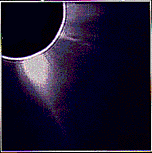






(Images within this animation are from the coronograph aboard the Solar Maximum Mission (SMM) and were provided courtesy of Arthur J. Hundhausen of HAO and NASA) What does the sun's outer atmosphere look like right now? |
Perhaps the most important solar event for the people on Earth is a coronal mass ejection because it can produce spectacular space weather events at Earth.
Periodically, the sun violently expells a huge bubble of gas (called a coronal mass ejection) from its outer atmosphere into space. During the course of such an event on average, several billion tons of gas are blown toward Earth. This is equivalent to the mass contained in a small lake but vaporized and traveling at millions of miles an hour (thousands of kilometers per second). The total energy contained in these high speed charged gases during a large event is roughly the same as a large solar flare (approximately equivalent to the total energy of 100 hurricanes) but expelled over a longer time period than a solar flare (many hours as compared to tens of minutes). This high speed gas bubble expands rapidly into space rivally the sun in size in just a matter of hours. It ploughs into the slower solar wind streaming outward from the sun creating shock waves. In these shock waves, a fraction of the particles are accelerated to dangerously high energies before they encounter the Earth. |